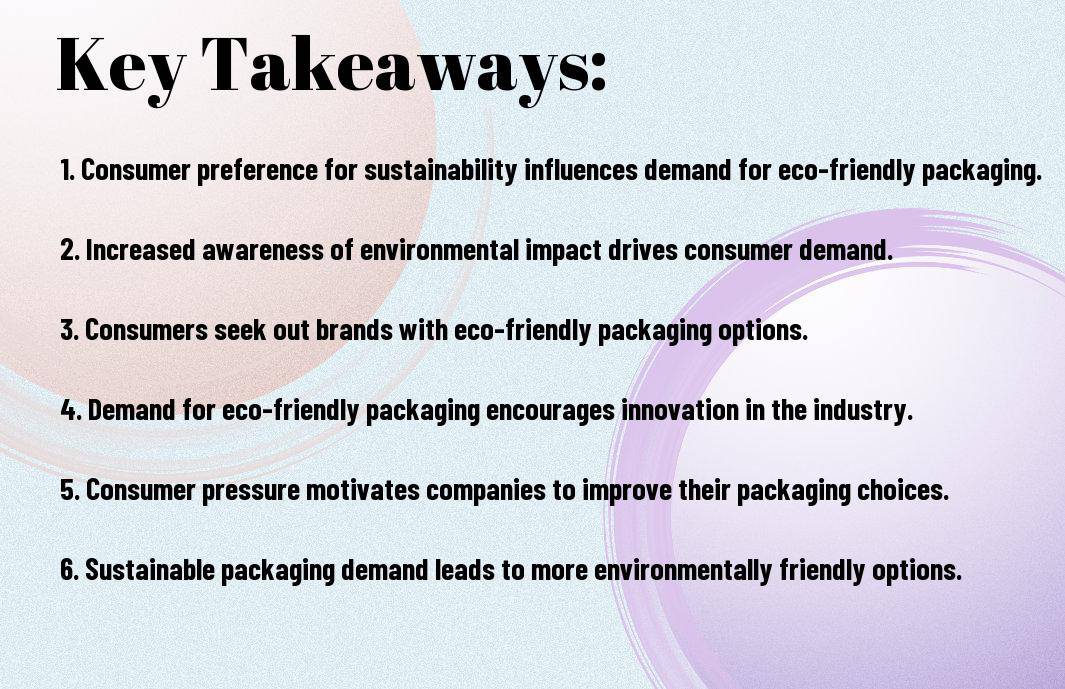Indubitably, the choices you make as a consumer have a significant impact on the demand for eco-friendly food packaging. By opting for biodegradable and recyclable packaging options, you are sending a clear message to manufacturers and retailers that sustainable packaging is non-negotiable. This blog post will explore the pivotal role you play in driving the demand for eco-friendly food packaging, and the power you hold to influence positive change in the food industry.
Key Takeaways:
- Consumer Awareness: Consumers play a crucial role in driving the demand for eco-friendly food packaging by being aware of the environmental impact of conventional packaging and seeking alternatives that are more sustainable.
- Purchasing Power: The choices consumers make at the grocery store directly influence the demand for eco-friendly food packaging. By choosing products with sustainable packaging, consumers can encourage manufacturers to adopt more environmentally friendly practices.
- Advocacy and Influence: Consumer demand for eco-friendly food packaging can also impact industry practices and government policies. As consumers voice their preferences for sustainable packaging, companies and policymakers are more likely to respond by implementing changes to meet these demands.

A Review of Food Packaging Trends
As you delve into the world of food packaging, it is essential to understand the trends and changes that have occurred over the years. By reviewing these trends, you can gain a deeper insight into the impact of consumer demand on eco-friendly packaging.
Traditional Vs. Eco-Friendly Packaging
Traditional food packaging has long been associated with materials such as plastic, polystyrene, and aluminium, which are not environmentally friendly. These materials are non-biodegradable and can have a significant impact on the environment, causing pollution and contributing to landfill waste. In contrast, eco-friendly packaging materials, such as biodegradable plastics, compostable paper, and plant-based packaging, offer more sustainable alternatives. The shift towards eco-friendly packaging is driven by your growing awareness of the environmental impact of traditional packaging materials.
The Rise of Biodegradable and Compostable Packaging
In recent years, there has been a notable increase in the availability of biodegradable and compostable packaging options. These materials are designed to break down naturally, minimising their impact on the environment. Unlike traditional packaging, biodegradable and compostable options offer you the opportunity to reduce the carbon footprint of your food purchases. This shift reflects your desire to make more environmentally conscious decisions when it comes to packaging and waste management.
The Role of Consumers in Driving eco-friendly food packaging
Consumer demand plays a crucial role in driving the need for eco-friendly food packaging. As you become more aware of the impact of packaging on the environment, your choices as a consumer can significantly influence the market trends towards sustainability. According to Sustainable Packaging Statistics: Why Eco-Friendly Packaging Matters, consumers are increasingly seeking out sustainable and eco-friendly packaging options, driving the demand for businesses to adopt greener practices.
Consumer Awareness about the Need for Sustainable Practices
It’s important for you to understand the need for sustainable practices, particularly in the context of food packaging. With the rising concerns about climate change and environmental pollution, your awareness of the impact of non-biodegradable packaging materials such as plastics is crucial. By educating yourself about the benefits of eco-friendly packaging, you can make informed choices that drive the demand for more sustainable options. Your understanding of the need for sustainable practices will empower you to influence the market positively.
How Consumers Can Influence the Market Trends
Your purchasing decisions hold significant power to influence market trends. By actively opting for products with eco-friendly packaging and consciously avoiding those with excessive or non-recyclable packaging, you send a clear message to businesses. Manufacturers and retailers are likely to respond to the demand for sustainable packaging when they see that consumers like you are prioritising environmentally friendly options. Your choices can lead to a shift in the industry towards more sustainable and less harmful packaging materials, creating a positive impact on the environment.
Case Studies of Successful Eco-friendly Packaging Shifts
When it comes to successful eco-friendly packaging initiatives, there are several case studies that stand out as shining examples of positive change. Here are a few noteworthy examples:
- Tesco: Tesco, a leading UK retailer, reduced its overall plastic use by 29% in just one year by introducing eco-friendly packaging across its products.
- Unilever: Unilever’s switch to biodegradable and compostable packaging for their leading brands has resulted in a 30% reduction in plastic waste.
- McDonald’s: McDonald’s decision to transition to eco-friendly packaging alternatives has led to a 32% decrease in plastic waste across its global operations.
If you want to explore more in-depth case studies and data on consumers’ response to environmentally-friendly food packaging, you can refer to this research paper.
Influence of Consumer Demand in Company Decisions
The demand for eco-friendly food packaging from consumers has had a significant impact on the decisions made by companies. As a result of the increasing preference for sustainable packaging options, many companies have been driven to re-evaluate their packaging materials and processes. Your choices as a consumer have directly influenced these decisions, encouraging companies to adopt more environmentally-friendly practices.
Challenges and Successes in the Transition to Eco-Friendly Packaging
The shift towards eco-friendly packaging has not been without its challenges, but there have been many successes along the way. Incorporating sustainable materials and redesigning packaging formats comes with its own set of obstacles, but the positive impact on the environment and consumer satisfaction has been undeniable. This transition represents a crucial step towards a more sustainable and responsible approach to packaging in the food industry.
Strategies for Further Encouragement of Eco-friendly Packaging
Now that you understand the impact consumers have on driving the demand for eco-friendly food packaging, it’s important to consider strategies for furthering this encouragement. According to a McKinsey report, consumers are increasingly prioritising sustainability and are willing to back it up with their spending habits. You can read more about this trend here.
Public Education and Awareness Raising
One strategy for encouraging the demand for eco-friendly food packaging is through public education and awareness raising. By informing consumers about the environmental impact of different packaging materials and the benefits of choosing eco-friendly options, you can empower them to make more sustainable choices. This can be achieved through advertising campaigns, educational initiatives, and partnerships with environmental organisations. Educating consumers about the significance of their choices can have a significant impact on their purchasing behaviour.
Policy Recommendations for Promoting Sustainable Packaging
Another crucial strategy involves policy recommendations for promoting sustainable packaging. Governments and regulatory bodies can play a key role in shaping consumer behaviour by implementing regulations and incentives that encourage the use of eco-friendly packaging. This can include measures such as imposing taxes on non-recyclable materials, offering subsidies for sustainable packaging initiatives, and creating standards for eco-friendly labelling. By establishing policies that support sustainable packaging, you can create a more conducive environment for eco-friendly choices and contribute to a more sustainable future.
Consumers’ Impact on Driving the Demand for Eco-Friendly Food Packaging
Following this discussion, it is evident that consumers play a crucial role in driving the demand for eco-friendly food packaging. Your purchasing choices and preferences directly influence the market demand for sustainable and environmentally-friendly packaging solutions. By opting for products with eco-friendly packaging and actively supporting brands that prioritise sustainability, you are actively contributing to the demand for more sustainable packaging options. As such, your choices as a consumer have the power to drive positive change in the food packaging industry, ultimately influencing manufacturers and retailers to adopt more sustainable practices.
FAQ
Q: What role do consumers play in driving the demand for eco-friendly food packaging?
A: Consumers play a crucial role in driving the demand for eco-friendly food packaging. Their preferences and purchasing decisions directly impact the choices made by manufacturers and suppliers.
Q: Why is consumer demand important for eco-friendly food packaging?
A: Consumer demand fuels the market for eco-friendly food packaging, encouraging companies to invest in sustainable initiatives and innovative packaging solutions. It also supports the development of greener alternatives to traditional packaging materials.
Q: How can consumers influence the demand for eco-friendly food packaging?
A: Consumers can influence demand by actively seeking out and purchasing products with eco-friendly packaging, expressing their preferences to manufacturers and retailers, and supporting sustainable brands and initiatives through their spending habits.
Q: What are the benefits of consumers choosing eco-friendly food packaging?
A: Choosing eco-friendly food packaging can lead to reduced environmental impact, decreased use of non-renewable resources, and lower levels of pollution and waste. It also supports a more sustainable and responsible approach to food packaging.
Q: What role does consumer education play in driving demand for eco-friendly food packaging?
A: Consumer education is vital in raising awareness about the environmental impact of traditional packaging and the benefits of eco-friendly alternatives. It empowers consumers to make informed choices and understand the importance of their role in driving demand for sustainable packaging solutions.



